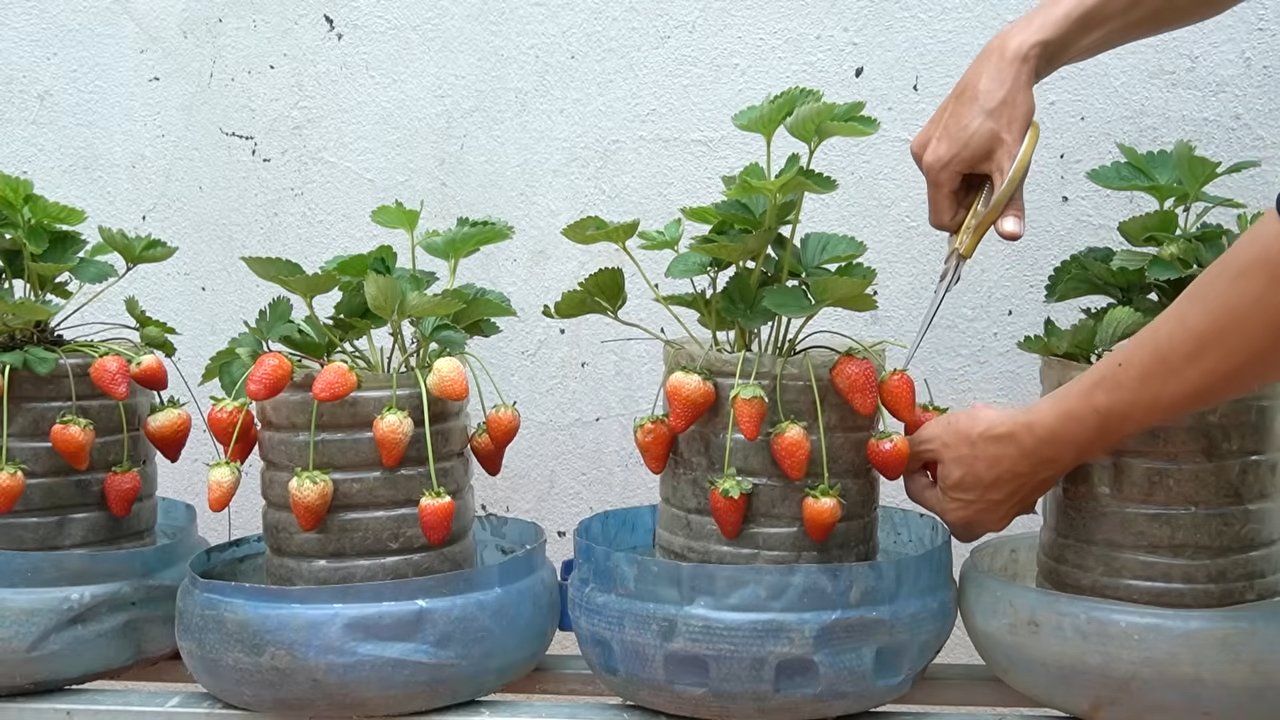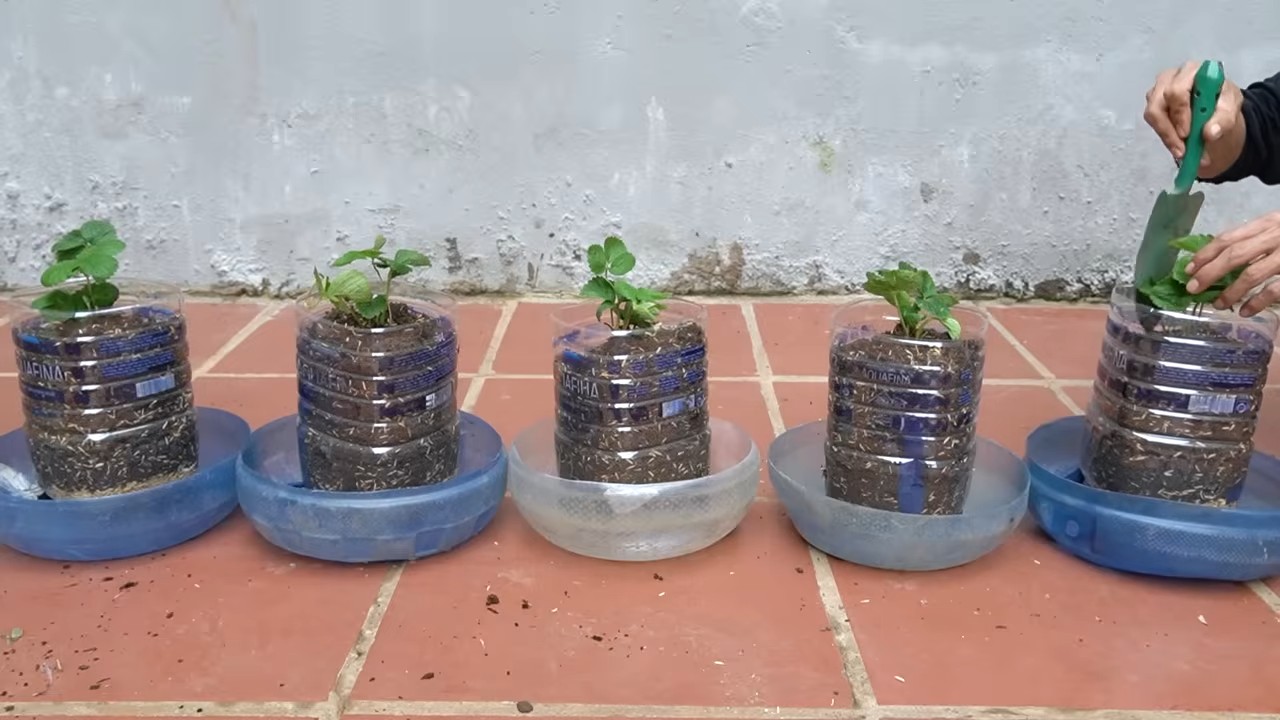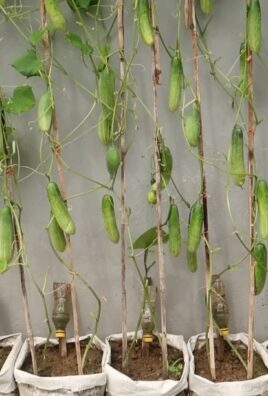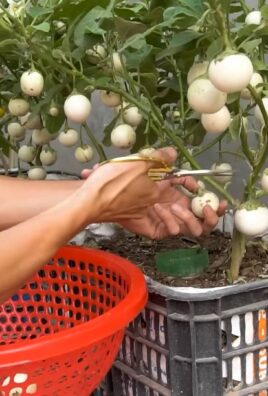Growing Strawberries Monthly might seem like a far-fetched dream, especially if you’ve struggled with these delightful berries in the past. But what if I told you that with a few clever tricks and DIY hacks, you could be enjoying a continuous harvest of sweet, juicy strawberries, month after month?
For centuries, strawberries have been cherished not only for their delicious flavor but also for their vibrant color and nutritional benefits. From ancient Roman gardens to the strawberry fields of modern-day California, these berries have held a special place in our hearts and diets. But let’s face it, getting a consistent yield can be tricky. Pests, diseases, and unpredictable weather can all conspire to ruin your strawberry dreams.
That’s where this DIY guide comes in! I’m going to share some simple, yet effective, techniques that will help you master the art of growing strawberries monthly. Whether you’re a seasoned gardener or just starting out, these tips will empower you to create a thriving strawberry patch that provides a continuous supply of fresh berries for your family and friends. Imagine the joy of picking your own strawberries for breakfast, adding them to smoothies, or baking them into delicious desserts – all year round! So, let’s dive in and unlock the secrets to a bountiful strawberry harvest!

Growing Strawberries Monthly: A DIY Guide to Year-Round Berry Bliss
Okay, strawberry lovers, listen up! I’m about to share my secret to enjoying fresh, juicy strawberries practically every month of the year. It’s not magic, just a little planning and some clever techniques. We’re going to dive into a DIY system that combines different strawberry varieties, strategic planting, and indoor growing to keep those berries coming. Get ready to roll up your sleeves and get your hands dirty!
Understanding Strawberry Types
Before we even think about planting, it’s crucial to understand the different types of strawberries. This is the key to extending your harvest. There are three main types:
* June-Bearing: These produce one large crop, usually in late spring or early summer (hence the name!). They’re great for making jam or freezing.
* Everbearing: These produce two or three crops per year – one in spring, one in late summer/early fall, and sometimes a smaller one in between.
* Day-Neutral: These are the workhorses of our year-round system. They produce fruit continuously throughout the growing season, as long as the temperature is between 35°F and 85°F.
Planning Your Strawberry Patch
The goal is to have a staggered harvest, so we’ll use a combination of all three types. Here’s a basic plan:
* June-Bearing: Plant these for a big early-season harvest.
* Everbearing: Plant these to fill in the gaps between the June-bearing and day-neutral varieties.
* Day-Neutral: These will be your steady producers, providing berries throughout the warmer months and even into the winter with some protection.
Getting Started: What You’ll Need
Here’s a list of everything you’ll need to get started. Don’t worry, it’s not as daunting as it looks!
* Strawberry Plants: A mix of June-bearing, everbearing, and day-neutral varieties. I recommend starting with at least 6-12 plants of each type.
* Containers: Various sizes, from small pots for starting seeds to larger containers for mature plants. I like using a mix of terracotta and plastic pots.
* Potting Mix: A high-quality, well-draining potting mix is essential. Avoid using garden soil, as it can compact and suffocate the roots.
* Fertilizer: A balanced fertilizer specifically formulated for strawberries. I prefer a slow-release granular fertilizer and a liquid fertilizer for supplemental feeding.
* Grow Lights (Optional): If you plan to grow strawberries indoors during the winter, you’ll need grow lights to provide adequate light.
* Seed Starting Trays (Optional): If you’re starting your strawberries from seed, you’ll need seed starting trays and a humidity dome.
* Mulch: Straw mulch is ideal for strawberries, as it helps retain moisture, suppress weeds, and keep the berries clean.
* Row Covers (Optional): Row covers can protect your plants from frost and extend the growing season.
* Watering Can or Hose: For watering your plants.
* Gardening Gloves: To protect your hands.
* Trowel: For planting and transplanting.
* Pruning Shears: For trimming runners and dead leaves.
Step-by-Step Planting Guide
Okay, let’s get planting! I’m going to break this down into sections to make it easier to follow.
Planting Outdoors
1. Choose the Right Location: Strawberries need at least 6-8 hours of sunlight per day. Choose a location with well-draining soil.
2. Prepare the Soil: Amend the soil with compost or other organic matter to improve drainage and fertility.
3. Planting: Dig a hole that’s large enough to accommodate the root ball of the strawberry plant. Gently remove the plant from its container and loosen the roots. Place the plant in the hole, making sure the crown (the point where the roots meet the stem) is level with the soil surface. Backfill the hole with soil and gently firm it around the plant.
4. Watering: Water the newly planted strawberries thoroughly.
5. Mulching: Apply a layer of straw mulch around the plants to retain moisture and suppress weeds.
6. Spacing: Space June-bearing plants 18-24 inches apart in rows that are 3-4 feet apart. Everbearing and day-neutral plants can be spaced closer together, about 12 inches apart.
Planting in Containers
1. Choose the Right Container: Select a container that’s at least 8 inches deep and wide. Make sure the container has drainage holes.
2. Fill with Potting Mix: Fill the container with a high-quality potting mix.
3. Planting: Follow the same planting instructions as for outdoor planting, making sure the crown of the plant is level with the soil surface.
4. Watering: Water the newly planted strawberries thoroughly.
5. Fertilizing: Container-grown strawberries need to be fertilized more frequently than those grown in the ground. Use a balanced fertilizer every 2-3 weeks.
Starting Strawberries from Seed (Optional)
This is a more advanced technique, but it’s a great way to grow unique varieties.
1. Sow Seeds: Sow strawberry seeds indoors 8-10 weeks before the last expected frost. Use seed starting trays filled with seed starting mix.
2. Lightly Cover: Lightly cover the seeds with soil. Strawberry seeds need light to germinate.
3. Watering: Water the seeds gently and keep the soil moist but not soggy.
4. Humidity: Cover the seed starting trays with a humidity dome to maintain high humidity.
5. Light: Place the seed starting trays under grow lights or in a sunny window.
6. Germination: Strawberry seeds can take several weeks to germinate. Be patient!
7. Transplanting: Once the seedlings have developed a few true leaves, transplant them into individual pots.
8. Harden Off: Before planting the seedlings outdoors, harden them off by gradually exposing them to outdoor conditions over a period of 1-2 weeks.
Caring for Your Strawberry Plants
Now that your strawberries are planted, it’s time to take care of them!
1. Watering: Strawberries need consistent moisture, especially during fruiting. Water deeply whenever the top inch of soil feels dry. Avoid overhead watering, as this can promote fungal diseases.
2. Fertilizing: Fertilize your strawberries regularly with a balanced fertilizer. Follow the instructions on the fertilizer label.
3. Weeding: Keep the area around your strawberry plants free of weeds. Weeds compete with strawberries for nutrients and water.
4. Pruning: Remove runners (the long stems that grow out from the main plant) from June-bearing strawberries to encourage fruit production. Everbearing and day-neutral strawberries can produce fruit on runners, so you can leave some of them if you want to propagate new plants. Also, remove any dead or diseased leaves.
5. Pest and Disease Control: Monitor your strawberry plants for pests and diseases. Common pests include aphids, spider mites, and slugs. Common diseases include gray mold and leaf spot. Treat any problems promptly with appropriate pesticides or fungicides. I always prefer organic options when possible!
6. Winter Protection: In cold climates, protect your strawberry plants from frost by covering them with row covers or straw mulch. Container-grown strawberries can be moved indoors to a cool, bright location.
Indoor Strawberry Growing
This is where the “monthly” part really kicks in! Growing strawberries indoors allows you to extend the harvest season and even enjoy fresh berries during the winter.
1. Choose the Right Variety: Day-neutral varieties are the best choice for indoor growing, as they produce fruit continuously throughout the year.
2. Provide Adequate Light: Strawberries need at least 6-8 hours of light per day. If you don’t have a sunny window, you’ll need to use grow lights.
3. Maintain the Right Temperature: Strawberries prefer temperatures between 60°F and 80°F.
4. Pollination: Indoor strawberries need to be pollinated by hand. Use a small paintbrush to transfer pollen from one flower to another.
5. Watering and Fertilizing: Water and fertilize your indoor strawberries regularly, just like you would outdoor plants.
Harvesting Your Strawberries
The moment we’ve all been waiting for!
1. Harvest When Ripe: Strawberries are ripe when they are fully red and slightly soft to the touch.
2. Gently Pick: Gently pick the strawberries from the plant, leaving a small piece of the stem attached.
3. Enjoy!

Conclusion
So, there you have it! Mastering the art of growing strawberries monthly isn’t just a pipe dream; it’s an achievable reality with a little planning and the right approach. We’ve explored the key elements, from selecting the right varieties and providing optimal growing conditions to implementing succession planting and diligently managing pests and diseases. The beauty of this method lies in its ability to transform your garden into a continuous source of fresh, juicy strawberries, far beyond the typical seasonal harvest.
Why is this DIY trick a must-try? Because it empowers you to control the quality and quantity of your strawberry supply. Imagine stepping into your garden any month of the year and picking sun-ripened berries for your breakfast, desserts, or simply enjoying them as a healthy snack. No more relying on store-bought strawberries that may lack flavor or freshness. This method offers a sustainable and rewarding way to enjoy the fruits of your labor, literally!
But the journey doesn’t end here. Feel free to experiment with different strawberry varieties to discover which ones thrive best in your specific climate and growing conditions. Consider incorporating companion planting techniques to naturally deter pests and enhance the flavor of your strawberries. You could also explore vertical gardening methods to maximize space and create a visually stunning strawberry display.
Don’t be afraid to get creative and adapt these techniques to suit your individual needs and preferences. Perhaps you’ll discover a unique fertilizer blend that boosts strawberry production, or a clever pest control strategy that keeps your plants healthy and thriving. The possibilities are endless!
We wholeheartedly encourage you to embark on this exciting adventure of growing strawberries monthly. It’s a rewarding experience that will not only provide you with a continuous supply of delicious berries but also connect you with nature and deepen your understanding of the growing process.
Once you’ve tried this DIY trick, we’d love to hear about your experience! Share your successes, challenges, and any tips or tricks you’ve discovered along the way. Your insights could be invaluable to other gardeners who are eager to extend their strawberry harvest. Let’s create a community of strawberry enthusiasts who are passionate about growing their own fresh, delicious berries year-round.
Remember, the key to success lies in consistent effort and a willingness to learn. So, grab your gardening gloves, prepare your soil, and get ready to enjoy a bountiful harvest of strawberries every month of the year! Happy gardening!
Frequently Asked Questions (FAQ)
What are the best strawberry varieties for year-round growing?
The best strawberry varieties for year-round growing are typically day-neutral varieties. These varieties are not as sensitive to day length as June-bearing or everbearing types, allowing them to produce fruit throughout the growing season, provided temperatures are suitable. Some popular day-neutral varieties include Albion, Seascape, and San Andreas. However, it’s crucial to consider your local climate when selecting varieties. Research which day-neutral strawberries perform well in your region for optimal results. Experimenting with a few different varieties can also help you determine which ones are best suited to your specific growing conditions.
How do I protect my strawberry plants from frost in colder months?
Protecting your strawberry plants from frost is essential for maintaining a continuous harvest. Several methods can be employed, depending on the severity of the frost. For light frosts, covering the plants with horticultural fleece or burlap can provide sufficient insulation. For more severe frosts, consider using a cold frame or greenhouse to create a protected environment. You can also mulch heavily around the plants with straw or pine needles to insulate the roots. Watering the plants before a frost can also help, as the water releases heat as it freezes. Remember to remove the coverings during the day to allow for proper ventilation and sunlight exposure.
What type of soil is best for growing strawberries monthly?
Strawberries thrive in well-drained, slightly acidic soil with a pH between 5.5 and 6.5. The soil should be rich in organic matter to provide essential nutrients and retain moisture. Before planting, amend the soil with compost, well-rotted manure, or other organic amendments to improve its structure and fertility. Avoid heavy clay soils, as they can become waterlogged and lead to root rot. If you have clay soil, consider growing your strawberries in raised beds or containers with a well-draining potting mix. Regular soil testing can help you monitor the pH and nutrient levels and make necessary adjustments.
How often should I fertilize my strawberry plants for continuous production?
For continuous strawberry production, regular fertilization is crucial. Use a balanced fertilizer specifically formulated for strawberries, following the manufacturer’s instructions. Apply fertilizer every 4-6 weeks during the growing season. You can also supplement with liquid seaweed extract or fish emulsion to provide additional micronutrients. Avoid over-fertilizing, as this can lead to excessive foliage growth at the expense of fruit production. Monitor your plants for signs of nutrient deficiencies, such as yellowing leaves or stunted growth, and adjust your fertilization schedule accordingly.
How do I prevent pests and diseases from affecting my strawberry plants?
Preventing pests and diseases is essential for maintaining a healthy and productive strawberry patch. Implement integrated pest management (IPM) strategies, which focus on preventing problems before they occur. This includes selecting disease-resistant varieties, maintaining good air circulation, and removing any diseased or dead foliage promptly. Regularly inspect your plants for signs of pests or diseases, such as aphids, spider mites, or fungal infections. Use organic pest control methods, such as insecticidal soap or neem oil, to control pests. For fungal diseases, consider using copper-based fungicides or baking soda sprays. Crop rotation and companion planting can also help to reduce pest and disease pressure.
Can I grow strawberries monthly indoors?
Yes, you can grow strawberries monthly indoors, provided you can replicate the necessary growing conditions. Use day-neutral varieties and plant them in containers with a well-draining potting mix. Provide at least 6-8 hours of direct sunlight per day, or supplement with grow lights. Maintain a consistent temperature between 60-80°F (15-27°C). Water regularly, allowing the soil to dry slightly between waterings. Fertilize every 4-6 weeks with a balanced fertilizer. Hand-pollinate the flowers using a small brush to ensure fruit set. Indoor strawberry growing can be a rewarding way to enjoy fresh berries year-round, especially in regions with harsh winters.
How do I ensure proper pollination for my strawberry plants?
Proper pollination is essential for fruit set in strawberries. While strawberries are self-pollinating to some extent, they benefit from cross-pollination. In outdoor settings, bees and other pollinators typically handle pollination. However, in indoor settings or during periods of low pollinator activity, you may need to hand-pollinate the flowers. Use a small, soft brush to gently transfer pollen from one flower to another. Repeat this process every few days to ensure adequate pollination. You can also use a small fan to circulate air around the plants, which can help to distribute pollen.
What is succession planting, and how does it help with monthly strawberry harvests?
Succession planting is the practice of planting crops at staggered intervals to ensure a continuous harvest. For strawberries, this involves planting new plants every few weeks or months, depending on the variety and growing conditions. By staggering the planting times, you can have plants at different stages of development, ensuring a continuous supply of ripe berries. For example, you might plant a new batch of strawberry plants every month or two, so that as one batch finishes producing, another batch is just starting to ripen. This technique is essential for achieving a monthly strawberry harvest.




Leave a Comment